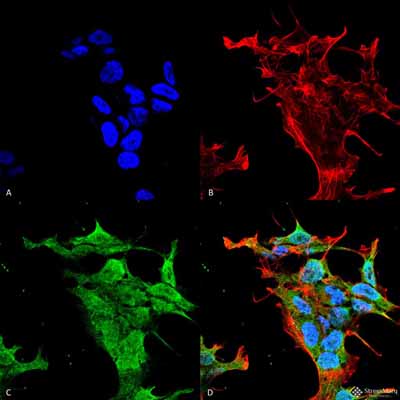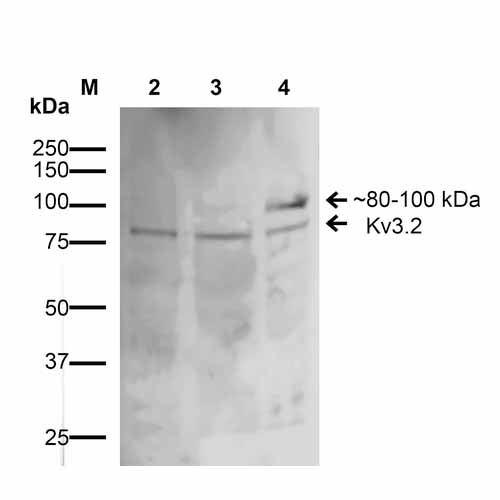Kv3.2 Antibody
Kv3.2 Antibody, Clone S410-17
- SPECIFICATION
- CITATIONS
- PROTOCOLS
- BACKGROUND

Application
| WB, IHC, ICC/IF |
|---|---|
| Primary Accession | P22462 |
| Other Accession | NP_631962.1 |
| Host | Mouse |
| Isotype | IgG1 |
| Reactivity | Human, Mouse, Rat |
| Clonality | Monoclonal |
| Description | Mouse Anti-Rat Kv3.2 Monoclonal IgG1 |
| Target/Specificity | Detects ~80-100kDa. Varies due to post-translational modifications. |
| Other Names | Potassium voltage-gated channel subfamily C member 2 Antibody, Kcnc2 Antibody, KSHIIIA Antibody |
| Clone Names | S410-17 |
| Immunogen | Fusion protein amino acids 474-613 (Cytoplasmic C-terminus) of rat Kv3.2a |
| Purification | Protein G Purified |
| Storage | -20ºC |
| Storage Buffer | PBS pH7.4, 50% glycerol, 0.1% sodium azide |
| Shipping Temperature | Blue Ice or 4ºC |
| Certificate of Analysis | A 1:100 dilution of SMC-492 was sufficient for detection of Kv3.2 in 20 µg of mouse brain lysate by ECL immunoblot analysis using Goat anti-mouse IgG:HRP as the secondary antibody. |
| Cellular Localization | Cell Membrane |

Thousands of laboratories across the world have published research that depended on the performance of antibodies from Abcepta to advance their research. Check out links to articles that cite our products in major peer-reviewed journals, organized by research category.
info@abcepta.com, and receive a free "I Love Antibodies" mug.
Provided below are standard protocols that you may find useful for product applications.
Background
Kv3.2, a member of the KCNC2 gene family, belongs to a group of potassium channels that contribute to the maintenance of cell volume, membrane potential, neuronal excitability and the secretion of transmitters, salt and hormones. Kv3.2 are predominantly expressed in neurons that fire at high frequencies, and in the fast spiking GABAergic interneurons of the neocortex, hippocampus, and caudate nucleus (1-3). They specifically functioning as a delayed rectifier activated by large membrane depolarizations (2, 4).
References
1. Kolodin Y.O. (2008) http://ykolodin.50webs.com/
2. Rudy B., McBain C.J. (2001) Trends Neurosci. 24(9): 517-526.
3. Gutman G.A., et al. (2005) Pharmacol Rev. 57(4): 472-508.
4. Rudy B, et al. (1999) Ann. NY Acad. Sci. 868: 304-343.
If you have used an Abcepta product and would like to share how it has performed, please click on the "Submit Review" button and provide the requested information. Our staff will examine and post your review and contact you if needed.
If you have any additional inquiries please email technical services at tech@abcepta.com.













 Foundational characteristics of cancer include proliferation, angiogenesis, migration, evasion of apoptosis, and cellular immortality. Find key markers for these cellular processes and antibodies to detect them.
Foundational characteristics of cancer include proliferation, angiogenesis, migration, evasion of apoptosis, and cellular immortality. Find key markers for these cellular processes and antibodies to detect them. The SUMOplot™ Analysis Program predicts and scores sumoylation sites in your protein. SUMOylation is a post-translational modification involved in various cellular processes, such as nuclear-cytosolic transport, transcriptional regulation, apoptosis, protein stability, response to stress, and progression through the cell cycle.
The SUMOplot™ Analysis Program predicts and scores sumoylation sites in your protein. SUMOylation is a post-translational modification involved in various cellular processes, such as nuclear-cytosolic transport, transcriptional regulation, apoptosis, protein stability, response to stress, and progression through the cell cycle. The Autophagy Receptor Motif Plotter predicts and scores autophagy receptor binding sites in your protein. Identifying proteins connected to this pathway is critical to understanding the role of autophagy in physiological as well as pathological processes such as development, differentiation, neurodegenerative diseases, stress, infection, and cancer.
The Autophagy Receptor Motif Plotter predicts and scores autophagy receptor binding sites in your protein. Identifying proteins connected to this pathway is critical to understanding the role of autophagy in physiological as well as pathological processes such as development, differentiation, neurodegenerative diseases, stress, infection, and cancer.



